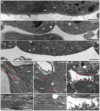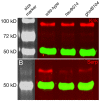Trafficking through COPII stabilises cell polarity and drives secretion during Drosophila epidermal differentiation
- PMID: 20520821
- PMCID: PMC2875407
- DOI: 10.1371/journal.pone.0010802
Trafficking through COPII stabilises cell polarity and drives secretion during Drosophila epidermal differentiation
Abstract
Background: The differentiation of an extracellular matrix (ECM) at the apical side of epithelial cells implies massive polarised secretion and membrane trafficking. An epithelial cell is hence engaged in coordinating secretion and cell polarity for a correct and efficient ECM formation.
Principal findings: We are studying the molecular mechanisms that Drosophila tracheal and epidermal cells deploy to form their specific apical ECM during differentiation. In this work we demonstrate that the two genetically identified factors haunted and ghost are essential for polarity maintenance, membrane topology as well as for secretion of the tracheal luminal matrix and the cuticle. We show that they code for the Drosophila COPII vesicle-coating components Sec23 and Sec24, respectively, that organise vesicle transport from the ER to the Golgi apparatus.
Conclusion: Taken together, epithelial differentiation during Drosophila embryogenesis is a concerted action of ECM formation, plasma membrane remodelling and maintenance of cell polarity that all three rely mainly, if not absolutely, on the canonical secretory pathway from the ER over the Golgi apparatus to the plasma membrane. Our results indicate that COPII vesicles constitute a central hub for these processes.
Conflict of interest statement
Figures












Similar articles
-
Sequential pulses of apical epithelial secretion and endocytosis drive airway maturation in Drosophila.Dev Cell. 2007 Aug;13(2):214-25. doi: 10.1016/j.devcel.2007.06.008. Dev Cell. 2007. PMID: 17681133
-
Molecular mechanisms that regulate export of the planar cell-polarity protein Frizzled-6 out of the endoplasmic reticulum.J Biol Chem. 2020 Jul 3;295(27):8972-8987. doi: 10.1074/jbc.RA120.012835. Epub 2020 May 6. J Biol Chem. 2020. PMID: 32376691 Free PMC article.
-
Apical secretion in epithelial tubes of the Drosophila embryo is directed by the Formin-family protein Diaphanous.Dev Cell. 2009 Jun;16(6):877-88. doi: 10.1016/j.devcel.2009.04.010. Dev Cell. 2009. PMID: 19531358
-
On vesicle formation and tethering in the ER-Golgi shuttle.Curr Opin Cell Biol. 2009 Aug;21(4):531-6. doi: 10.1016/j.ceb.2009.03.003. Epub 2009 Apr 23. Curr Opin Cell Biol. 2009. PMID: 19394211 Review.
-
Mechanisms of COPII vesicle formation and protein sorting.FEBS Lett. 2007 May 22;581(11):2076-82. doi: 10.1016/j.febslet.2007.01.091. Epub 2007 Feb 14. FEBS Lett. 2007. PMID: 17316621 Review.
Cited by
-
A Conserved Di-Basic Motif of Drosophila Crumbs Contributes to Efficient ER Export.Traffic. 2015 Jun;16(6):604-16. doi: 10.1111/tra.12273. Epub 2015 Apr 14. Traffic. 2015. PMID: 25753515 Free PMC article.
-
Trafficking mechanisms of extracellular matrix macromolecules: insights from vertebrate development and human diseases.Int J Biochem Cell Biol. 2014 Feb;47:57-67. doi: 10.1016/j.biocel.2013.11.005. Epub 2013 Dec 9. Int J Biochem Cell Biol. 2014. PMID: 24333299 Free PMC article. Review.
-
The ultrastructure of book lung development in the bark scorpion Centruroides gracilis (Scorpiones: Buthidae).Front Zool. 2011 Jul 27;8:18. doi: 10.1186/1742-9994-8-18. Front Zool. 2011. PMID: 21791110 Free PMC article.
-
Lateral adherens junctions mediate a supracellular actomyosin cortex in drosophila trachea.iScience. 2023 Mar 13;26(4):106380. doi: 10.1016/j.isci.2023.106380. eCollection 2023 Apr 21. iScience. 2023. PMID: 37009223 Free PMC article.
-
Novel mechanisms of tube-size regulation revealed by the Drosophila trachea.Cell Tissue Res. 2013 Nov;354(2):343-54. doi: 10.1007/s00441-013-1673-z. Epub 2013 Jul 4. Cell Tissue Res. 2013. PMID: 23824100 Free PMC article. Review.
References
Publication types
MeSH terms
Substances
LinkOut - more resources
Full Text Sources
Molecular Biology Databases

